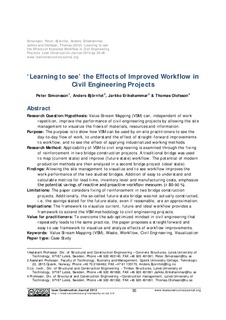| dc.contributor.author | Simonsson, Peter | |
| dc.contributor.author | Björnfot, Anders | |
| dc.contributor.author | Erikshammar, Jarkko | |
| dc.contributor.author | Olofsson, Thomas | |
| dc.date.accessioned | 2019-10-14T07:56:19Z | |
| dc.date.available | 2019-10-14T07:56:19Z | |
| dc.date.created | 2012-04-12T09:11:32Z | |
| dc.date.issued | 2012 | |
| dc.identifier.citation | Lean Construction Journal. 2012, 35-48. | nb_NO |
| dc.identifier.issn | 1555-1369 | |
| dc.identifier.uri | http://hdl.handle.net/11250/2621850 | |
| dc.description.abstract | Research Question/Hypothesis: Value Stream Mapping (VSM) can, independent of work repetition, improve the performance of civil engineering projects by allowing the site management to visualize the flows of materials, resources and information. Purpose: The purpose is to show how VSM can be used by on-site practitioners to see the day-to-day flow of work, to understand the effect of straight-forward improvements to workflow, and to see the effect of applying industrialized working methods. Research Method: Applicability of VSM to civil engineering is examined through the fixing of reinforcement in two bridge construction projects. A traditional bridge was used to map (current state) and improve (future state) workflow. The potential of modern production methods are then analyzed in a second bridge project (ideal state). Findings: Allowing the site management to visualize and to see workflow improves the work performance of the two studied bridges. Addition of easy to understand and calculable metrics for lead time, inventory level and manufacturing costs, emphasize the potential savings of reactive and proactive workflow measures (≈ 80-90 %). Limitations: The paper considers fixing of reinforcement in two bridge construction projects. Additionally, the so-called future state bridge was not actually constructed, i.e. the savings stated for the future state, even if reasonable, are an approximation. Implications: The framework to visualize current, future and ideal workflow provides a framework to extend the VSM methodology to civil engineering projects. Value for practitioners: To overcome the sub-optimized mindset in civil engineering that repeatedly leads to the same practice, the paper proposes a straightforward and easy to use framework to visualize and analyze effects of workflow improvements. | nb_NO |
| dc.description.abstract | ‘Learning to see’ the Effects of Improved Workflow in Civil Engineering Projects | nb_NO |
| dc.language.iso | eng | nb_NO |
| dc.publisher | Lean Construction Institute | nb_NO |
| dc.relation.uri | http://www.leanconstruction.org/lcj/2012/LCJ_11_005.pdf | |
| dc.rights | Attribution-NonCommercial-NoDerivatives 4.0 Internasjonal | * |
| dc.rights.uri | http://creativecommons.org/licenses/by-nc-nd/4.0/deed.no | * |
| dc.title | ‘Learning to see’ the Effects of Improved Workflow in Civil Engineering Projects | nb_NO |
| dc.type | Journal article | nb_NO |
| dc.type | Peer reviewed | nb_NO |
| dc.description.version | publishedVersion | nb_NO |
| dc.source.pagenumber | 35-48 | nb_NO |
| dc.source.journal | Lean Construction Journal | nb_NO |
| dc.identifier.cristin | 919698 | |
| dc.description.localcode | © This is an open access article distributed under the Creative Commons Attribution License | nb_NO |
| cristin.unitcode | 194,64,94,0 | |
| cristin.unitname | Institutt for vareproduksjon og byggteknikk | |
| cristin.ispublished | true | |
| cristin.fulltext | original | |
| cristin.qualitycode | 1 | |

